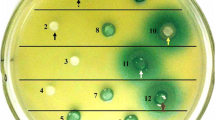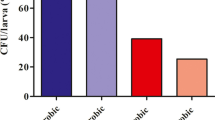Abstract
Many bacteria live in close association with sponges. Within these consortia, molecules of communication such as quorum-sensing and hormone-like molecules may occur in order to regulate the partnership. Of particular interest, bacterial N-acyl-l-homoserine lactones (AHLs) were screened in supernatants from Suberites domuncula-associated bacteria using an E. coli bioluminescent reporter system. These sponge-associated bacteria were beforehand isolated on several media supplemented or not with a sponge extract to attempt to isolate sponge-specific bacteria. Out of 81 AHL-producing bacteria, three strains requiring sponge extract to grow were selected for AHL characterization. The in vitro produced AHLs, that is, in bacterial culture supernatants, were identified as N-(3-butanoyl)-l-homoserine lactone and N-(3-oxododecanoyl)-l-homoserine lactone and quantified using LC–ESI–MS/MS. The in vivo production of AHLs by sponge-associated bacteria has also been demonstrated in a healthy host for the first time: N-(3-oxododecanoyl)-l-homoserine lactone, N-(3-hexanoyl)-l-homoserine lactone, and N-(3-heptanoyl)-l-homoserine lactone. This AHL production in sponges may suggest a potential role of these molecules between sponge-associated bacteria and/or between sponge-associated bacteria and the sponge.


Similar content being viewed by others
References
Böhn M, Hentschel U, Friedrich AB, Fieseler L, Steffen R, Gamulin V, Müller WE (2001) Molecular response of the sponge Suberites domuncula to bacterial infection. Mar Biol 139:1037–1045
Chhabra SR, Stead P, Bainton NJ, Salmond GP, Stewart GS, Williams P, Bycroft BW (1993) Autoregulation of carbapenem biosynthesis in Erwinia carotovora by analogues of N-(3-oxohexanoyl)-l-homoserine lactone. J Antibiot 46:441–454
de Bary HA (1879) Die erscheinung der symbiose. Verlag Trubner, Straßburg
Dobretsov S, Teplitski M, Paul V (2009) Quorum sensing in the marine environment and its relationship to biofouling. Biofouling 25:413–427
Duperron S, Nadalig T, Caprais JC, Sibuet M, Fiala-Médioni A, Amann R, Dubilier N (2005) Dual symbiosis in a Bathymodiolus sp. mussel from a methane seep on the Gabon continental margin (Southeast Atlantic): 16S rRNA phylogeny and distribution of the symbionts in gills. Appl Environ Microbiol 71:1694–1700
Ellwanger K, Nickel M (2006) Neuroactive substances specifically modulate rhythmic body contractions in the nerveless metazoon Tethya wilhelma (Demospongiae, Porifera). Front Zool 3:7
Fuqua WC, Winans SC, Greenberg EP (1994) Quorum sensing in bacteria: the LuxR-LuxI family of cell density-responsive transcriptional regulators. J Bacteriol 176:269–275
Horng YT, Deng SC, Daykin M, Soo PC, Wei JR, Luh KT, Ho SW, Swift S, Lai HC, Williams P (2002) The LuxR family protein SpnR functions as a negative regulator of N-acylhomoserine lactone-dependent quorum sensing in Serratia marcescens. Mol Microbiol 45:1655–1671
Jacobi CA, Schiffner F, Henkel M, Waibel M, Stork B, Daubrawa M, Eberl L, Gregor M, Wesselborg S (2009) Effects of bacterial N-acyl homoserine lactones on human Jurkat T lymphocytes-OdDHL induces apoptosis via the mitochondrial pathway. Int J Med Microbiol 299:509–519
Joint I, Tait K, Wheeler G (2007) Cross-kingdom signalling: exploitation of bacterial quorum sensing molecules by the green seaweed Ulva. Philos Trans R Soc Lond B Biol Sci 362:1223–1233
Kastbjerg VG, Nielsen KF, Dalsgaard I, Rasch M, Bruhn JB, Givskov M, Gram L (2007) Profiling acylated homoserine lactones in Yersinia ruckeri and influence of exogenous acyl homoserine lactones and known quorum-sensing inhibitors on protease production. J Appl Microbiol 102:363–374
Le Pennec G, Perovic S, Ammar MS, Grebenjuk VA, Steffen R, Brümmer F, Müller WE (2003) Cultivation of primmorphs from the marine sponge Suberites domuncula: morphogenetic potential of silicon and iron. J Biotechnol 100:93–108
Lithgow JK, Wilkinson A, Hardman A, Rodelas B, Wisniewski-Dyé F, Williams P, Downie JA (2000) The regulatory locus cinRI in Rhizobium leguminosarum controls a network of quorum-sensing loci. Mol Microbiol 37:81–97
Liu X, Jia J, Popat R, Ortori CA, Li J, Diggle SP, Gao K, Cámara M (2011) Characterization of two quorum sensing systems in the endophytic Serratia plymuthica strain G3: differential control of motility and biofilm formation according to life-style. BMC Microbiol 11:26
Mohamed NM, Cicirelli EM, Kan J, Chen F, Fuqua C, Hill RT (2008) Diversity and quorum-sensing signal production of Proteobacteria associated with marine sponges. Environ Microbiol 10:75–86
Morin D, Grasland B, Vallée-Réhel K, Dufau C, Haras D (2003) On-line high-performance liquid chromatography-mass spectrometric detection and quantification of N-acylhomoserine lactones, quorum-sensing signal molecules, in the presence of biological matrices. J Chromatogr A 1002:79–92
Morohoshi T, Inaba T, Kato N, Kanai K, Ikeda T (2004) Identification of quorum-sensing signal molecules and the LuxRI homologs in fish pathogen Edwardsiella tarda. J Biosci Bioeng 98:274–281
Morohoshi T, Yokoyama Y, Ouchi M, Kato N, Ikeda T (2009) Motility and the expression of the flagellin protein FliC are negatively regulated by quorum sensing in Edwardsiella tarda. J Biosci Bioeng 108:314–318
Müller WE, Wiens M, Müller IM, Schröder HC (2004) The chemokine networks in sponges: potential roles in morphogenesis, immunity and stem cell formation. Prog Mol Subcell Biol 34:103–143
Pontes MH, Babst M, Lochhead R, Oakeson K, Smith K, Dale C (2008) Quorum sensing primes the oxidative stress response in the insect endosymbiont. Sodalis glossinidius. PLoS One 3:e3541
Reading NS, Sperandio V (2006) Quorum sensing: the many languages of bacteria. FEMS Microbiol Lett 254:1–11
Redfield RJ (2002) Is quorum sensing a side effect of diffusion sensing? Trends Microbiol 10:365–370
Tamura K, Peterson D, Peterson N, Stecher G, Nei M, Kumar S (2011) MEGA5: molecular evolutionary genetics analysis using maximum likelihood, evolutionary distance, and maximum parsimony methods. Mol Biol Evol
Taylor MW, Schupp PJ, Baillie HJ, Charlton TS, de Nys R, Kjelleberg S, Steinberg PD (2004) Evidence for acyl homoserine lactone signal production in bacteria associated with marine sponges. Appl Environ Microbiol 70:4387–4389
Taylor MW, Radax R, Steger D, Wagner M (2007) Sponge-associated microorganisms: evolution, ecology, and biotechnological potential. Microbiol Mol Biol Rev 71:295–347
Thakur NL, Perovic-Ottstadt S, Batel R, Korzhev M, Diehl-Seifert B, Müller IM, Müller WE (2005) Innate immune defense of the sponge Suberites domuncula against Gram-positive bacteria: induction of lysozyme and AdaPTin. Mar Biol 146:271–282
Vikström E, Tafazoli F, Magnusson KE (2006) Pseudomonas aeruginosa quorum sensing molecule N-(3-oxododecanoyl)-l-homoserine lactone disrupts epithelial barrier integrity of Caco-2 cells. FEBS Lett 580:6921–6928
Wagner C, Zimmermann S, Brenner-Weiss G, Hug F, Prior B, Obst U, Hänsch GM (2007) The quorum-sensing molecule N-3-oxododecanoyl homoserine lactone (3OC12-HSL) enhances the host defense by activating human polymorphonuclear neutrophils (PMN). Anal Bioanal Chem 387:481–487
Wiens M, Korzhev M, Krasko A, Thakur NL, Perovic-Ottstadt S, Breter HJ, Ushijima H, Diehl-Seifert B, Müller IM, Müller WE (2005) Innate immune defense of the sponge Suberites domuncula against bacteria involves a MyD88-dependent signaling pathway. Induction of a perforin-like molecule. J Biol Chem 280:27949–27959
Wiens M, Korzhev M, Perovic-Ottstadt S, Luthringer B, Brandt D, Klein S, Müller WE (2007) Toll-like receptors are part of the innate immune defense system of sponges (Demospongiae: Porifera). Mol Biol Evol 24:792–804
Winson MK, Swift S, Fish L, Throup JP, Jørgensen F, Chhabra SR, Bycroft BW, Williams P, Stewart GS (1998) Construction and analysis of luxCDABE-based plasmid sensors for investigating N-acyl homoserine lactone-mediated quorum sensing. FEMS Microbiol Lett 163:185–192
Zan J, Fuqua C, Hill TH (2011) Diversity and functional analysis of luxS genes in vibrios from marine Mycale laxissima and Ircinia strobilina. ISME J 1–12
Zhang L, Murphy PJ, Kerr A, Tate ME (1993) Agrobacterium conjugation and gene regulation by N-acyl-l-homoserine lactones. Nature 362:446–448
Acknowledgments
This work was funded by the Axis 1 “Genomics and blue chemistry” of the GIS Europôle Mer, and European FEDER. JG was the recipient of a doctoral fellowship from the Ministère de l’Enseignement Supérieur et de la Recherche, France.
Author information
Authors and Affiliations
Corresponding authors
Additional information
Communicated by M. Kühl.
Electronic supplementary material
Below is the link to the electronic supplementary material.
Rights and permissions
About this article
Cite this article
Gardères, J., Taupin, L., Saïdin, J.B. et al. N-acyl homoserine lactone production by bacteria within the sponge Suberites domuncula (Olivi, 1792) (Porifera, Demospongiae). Mar Biol 159, 1685–1692 (2012). https://doi.org/10.1007/s00227-012-1956-z
Received:
Accepted:
Published:
Issue Date:
DOI: https://doi.org/10.1007/s00227-012-1956-z




